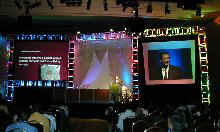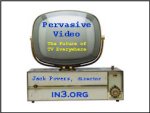|
|
|
||
The Journal of the International Informatics Institute |
|||
The International Informatics Institute is a center for research, education and consulting on the application of new technologies to global business and society. Education >Education
Home
EVENT WEB SITE:
|
Following up on IN3's pervasive computing research, Jack Powers' keynote opened the NAB Super Session Creating Content for Anyone, Anywhere and on Any Device with a discussion of pervasive video and audio, the perils of digital encryption and streaming media for broadcasters, and the developing all-media content architecture. An audience of more than 300 broadcast professionals viewed the talk live. CREATING CONTENT FOR ANYONE, ANYWHERE AND ON ANY DEVICE Tuesday, Apr 9, 2002 New breakthroughs will soon enable the delivery of visually rich, personalized content anytime, anywhere, on any device. This third wave of publishing – Network Publishing – that follows desktop publishing of the ‘80s and traditional Web publishing in the ‘90s recognizes the dramatic change in the way content is being created, managed and delivered. This is a visionary session that promises to provide industry insights and tips straight from the experts about emerging tools, techniques and technologies for creating and delivering streaming media content in the new world of network publishing for wireless mobile devices.
2:00PM - 2:30PM Computers are evolving and
getting better, changing the way users choose,
Jack Powers, Director,
KEYNOTE SLIDE TEXT Creating Content for Anyone, Video and Audio Everywhere Content Everywhere Revenue Everywhere Technology sucks the profit off of everyone’s balance sheet. Mass Customization In an age of content everywhere, robots will help choose our media and tune it to our interests. 1. Get used to customers in control. 2. Be ready to trim margins to grow 3. Keep smart about all the new tech. 4. Build databases, not libraries. 5. Create intelligent branded content What a great time to be alive! Jack's recent notes on Big media and governments As digital technologies mature, video is everywhere: On networked home computers, on office computers running news and elearning, on pocket computers, automotive computers, signs and cell phones. Following the tech revolution of pervasive computing, we're moving toward pervasive video in the next three to five years. Spurred by Napster's effect on the music business, global media firms are pressing for draconian security controls on digital equipment that will enable them to restrict the viewing of movies and other material distributed online. (See Hollings) These restrictions can't work. Technology will always rush ahead of legislation, and although the great and powerful entertainment industry would like special chips to protect their oligopoly, the great and even more powerful IT business has no need for digital restrictions. Movie companies that make their money parceling out restricted access to a scarce product have cause to worry about the digital control of their hand-crafted content, but broadcasting operations should embrace a world free of distribution and viewing restrictions. The broadcast business model depends on reaching the widest audience possible -- through terrestrial stations, cable, satellite and now the Internet -- and then making money on advertising, sponsorship, subscriptions or even end-user transactions. Big media firms own both movie studios and broadcasting outlets, but in this case what's good for the theatrical side of the business is not good for the broadcasters. Broadcasters should exploit the digital revolution and make their businesses friendly to pervasive video. Like CNN, make it easy to subscribe to web- delivered TV. Like Yahoo, consider revenues from pay TV in the enterprise. Like AOL Music, mix free and subscription formats to take advantage of interactivity. Like RealNetworks, bundle diverse news, sports and entertainment into compelling new channels. Like Microsoft, think about handheld TV in pocket computers. Like Motorola, imagine two-way TV to billions of cell phones. The easy part is seeing the future; the hard part is preparing your company for it. For broadcasters, syndicators, cable programmers and other video content producers, we'll discuss five maxims to guide development in the age of pervasive video. |
JUNE 2004 UPDATE Pervasive TV for Advertisers
PDA Video Blog
ADVERTISING & MARKETING LAW Jack Powers, Director of the International Informatics Institute, provided a technological and commercial perspective on emerging pervasive TV technologies in the Age of TiVO.
Download Jack's slides from the IN3 conference courseware page. Mobile TV Demo NEWS & PERSPECTIVE How to TiVo-ize your PC Jack's House Will TV Come to a Cell Phone Near You? Jack's related notes for Short form: Robots will pick our media for us. Longer form: With all the channels and choices in the world, no human can figure out what to watch. At my house I have a 250 channel DirectTV dish plus a 96 channel Time Warner cable box plus some 60 NY radio stations plus 2 billion web pages to look at plus God knows how many newspapers, magazines journals and what-not competing for my attention. And then I browse 4 million books on Amazon.com, 10,000 DVDs on NetFlix and thousands of video game titles for both consoles and PCs. Increasingly, I rely on artificial intelligence to find things that I'd like. WEB It's easiest to do on the web, so it started there first. Amazon.com's collaborative filtering robot remembers every book everybody has ever bought from them and finds patterns to use in its recommendations. I've never purchased a DVD from Amazon, but when I ask for a DVD recommendation the Amazon bot always suggests some of my favorite movies of all time. It figures the movie recommendations from the book purchases I've made. Importantly, the bot also suggest books and DVDs that I've never heard of but will probably like, things I would not have found on my own. This suggests a new form of marketing by pattern recognition. In fact, that's happening today. In music sharing systems like Naptser,
Kazaa and Morpheus, intelligent systems scan the music you've posted for
sharing and recommend new music based on your For comments and questions about this upcoming presentation, contact:
|
The Entertainment Economy: How Mega-Media Forces Are Transforming
Our Lives
Amazon.com:
|
© 1995-2002 International Informatics Institute, Inc. All Rights Reserved. Read our privacy guidelines. Contact us. |
|||




